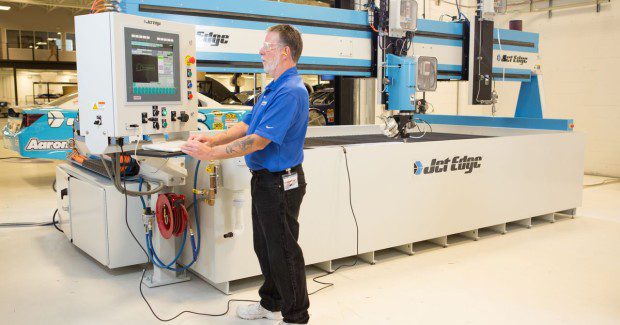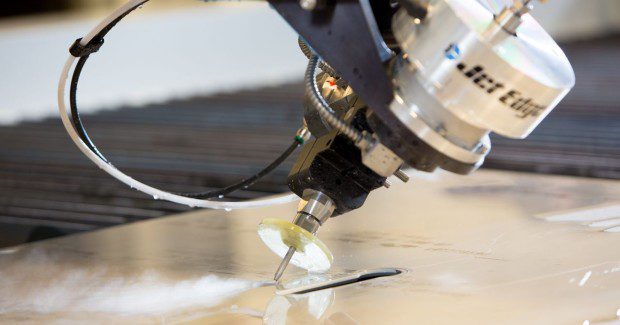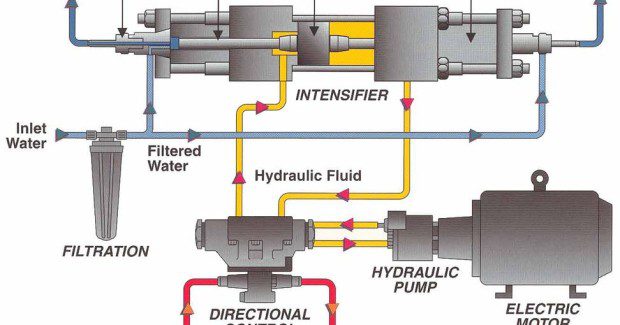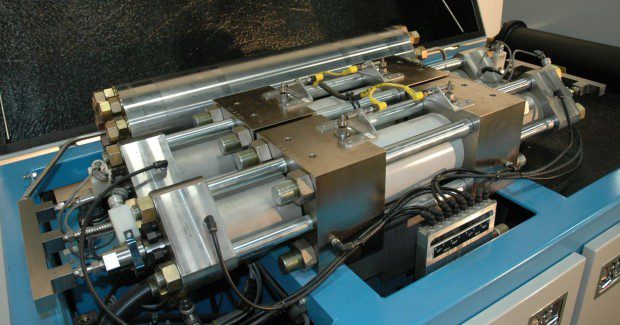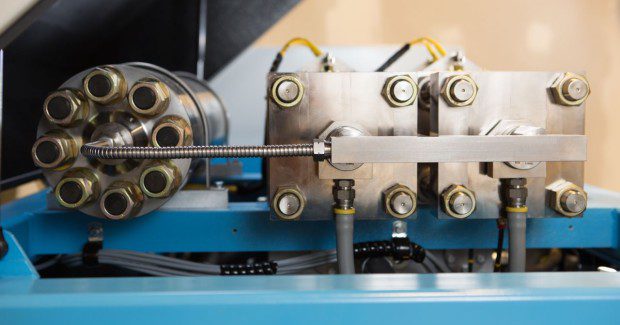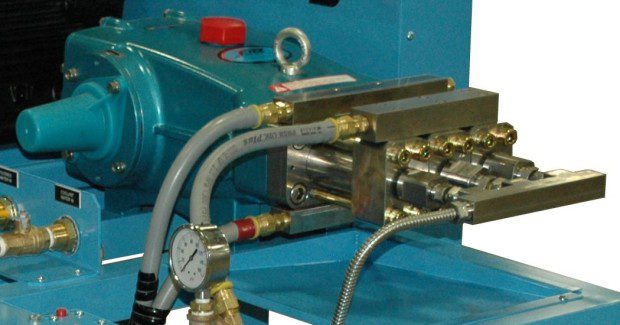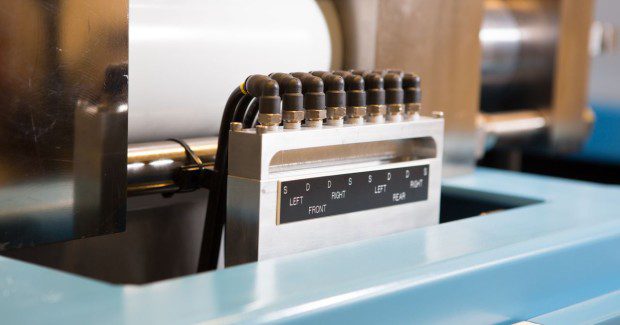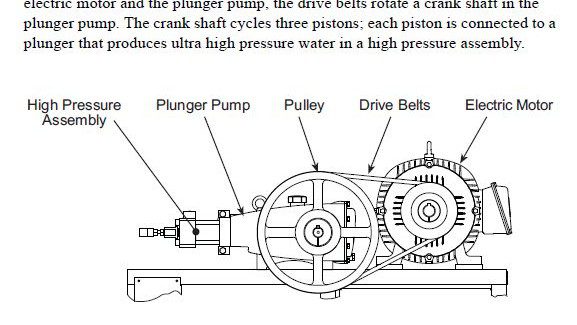A Closer Look at Ultra-High Pressure Waterjet Pumps
Which pump is right for your shop? Here is a look at how a water intensifier system operates, different system configurations, and the specific things to look for in the pump system regarding the waterjet application required.
Posted: August 9, 2013
With operating pressures often exceeding 75,000 psi (5,200 bar), ultra-high pressure waterjet systems turn tap water and sand into a powerful abrasivejet that cuts through steel like butter and machines parts from super alloys like Inconel® with no hesitation. At the heart of this versatile technology is the waterjet pump. This specially engineered pump converts 60 psi tap water into a supersonic waterjet that makes a high-end 4,000 psi (276 bar) pressure washer look like a child’s toy.
Most waterjet systems are powered by a hydraulically-driven intensifier pump or a direct drive-drive/positive displacement pump. Hydraulic intensifier pumps use hydraulic pressure to drive the pump’s plunger, while direct-drive pumps use a crank to drive the plunger. Hydraulic intensifier pumps can reach extreme operating pressures of 75,000 psi+, while direct-drive pumps can reach pressures of 55,000-60,000 psi (3,800-4,100) bar.
In both systems, the piston/plunger assembly reciprocates, generating pressure on the power stroke. The inlet stroke brings filtered water into the high pressure cylinder through a check valve assembly. After the plunger reverses direction, the water exits as ultra-high pressure water and then enters an attenuator. The attenuator smoothes pressure fluctuations produced by the intensifier and delivers a consistent, steady stream of ultra-high pressure water to the cutting or cleaning tool. This stream is then forced through a very small diameter diamond or ruby orifice, creating a fishing line thin waterjet that is travelling faster than a bullet.
Typically, an abrasive material, such as garnet, is added to the water stream to create an abrasive waterjet that can cut through virtually any material. In fact, pure waterjet can be used to cut soft materials, such as food, foam or rubber.
WHICH PUMP IS RIGHT FOR MY SHOP?
In addition to the two different pump designs, a wide range of pressures are available, from 36,000 psi (2,500 bar), to 60,000 psi to 90,000 psi+. Motor sizes range from 30-280 hp and flow rates range from under a gallon a minute to several gallons a minute. With so many options, picking the perfect pump can be a daunting task.
Waterjet industry veterans Bradley Schwartz and Jeff Schibley of Jet Edge, Inc. (St. Michael, MN) have helped countless waterjet shops select the right pump over the years. Here they share a few tips on how to pick the right pump: “Picking the perfect pump always begins by identifying your specific application,” explains Schibley, noting that this will help your pump manufacturer determine the pressure, horsepower, flow rate and other requirements to cut your parts at the lowest possible costs.
“We’ll ask you several questions,” he continues. “What are you cutting? How fast do we need to cut the product? Can we make the desired throughput requirements with a single nozzle? Does the application require multiple nozzles? Can the cutting application be performed with straight water? Does the application require the addition of abrasive?”
Schwartz notes that a reputable waterjet manufacturer will always help the user determine the most efficient and cost-effective pump for their application and budget. He explains that hydraulic-style pumps are the typical pump of choice for shops that need to process higher volumes of material or thicker material, while lower-cost direct-drive pumps are a good economical alternative for shops that only require an entry level system for low-volume cutting.
“We have always been a proponent of hydraulic intensifier pumps because they are easier to maintain and have lower maintenance costs and less downtime,” he says. “We do offer direct drive pumps, however, because sometimes that is all a shop has a budget for and it really may be all they need.” Most waterjet manufacturers offer free test cuts to help shops determine the appropriate pump and motion system set up for their application. During the test cut, the manufacturer will run a series of tests to determine the most efficient cutting pressure, horsepower, and speed to achieve the desired throughput requirements.
“During the test, we determine if we can process the material with straight water or if we need to add abrasive,” adds Schibley. “We also determine how much pressure, what orifice size and how many cutting heads are required to make their throughput requirements. If the application requires abrasive, we determine how much abrasive is required and the most efficient orifice/nozzle combination. Once we have calculated these factors, we can size the pump and flow rate.”
Schwartz notes that the test cut will help the user select the most cost-effective pump for their application and will also arm them with cutting data that will help them keep their operating costs as low as possible by running their system at the most cost-efficient pressure, using the least amount of abrasive necessary and running the appropriate number of cutting heads to achieve their desired throughput. “If I’m cutting nothing but very soft tile that cuts fine at 36,000 psi, I might as well put in a 36,000 psi pump and cut with six heads,” he says. “But if I’m cutting 3 in to 6 in thick steel all day long, I’ll need a 60,000 psi pump. If I want to use 50 hp per head and I plan to use two heads, that pump will need to be 100 hp.
“When I’m cutting upwards of a ¼ in thick material, I would use two heads and I would use 25 hp per head to cut it because I’m not going to be cutting that much slower than I would be at 50 hp, but I will use half the abrasive and I am using two heads so I will double my production,” continues Schwartz. “When I go up to 2 in thick material, I will shift to 50 hp per head. It only takes me a minute to change the orifice and nozzle to bring my horsepower up and down. That is how you change the horsepower: with different orifice sizes. At 60,000 psi, 25 hp uses a .010 in orifice. When you go to 50 hp, you use a .015” orifice.”
Of course, the pump must be within the planned budget, which might mean scaling back on horsepower or pressure and accepting a higher cost per part, notes Schibley. “We must take into consideration the shop’s financial considerations,” he says. “Just because a 60,000 psi 200 hp pump operating four .015 in/.045 in orifice/nozzle combinations makes the lowest cost cut, that doesn’t mean it is necessarily the best pump for the customer if it doesn’t meet his financial requirements.”
TAKING IT TO EXTREMES
For years, 55,000-60,000 psi has been the industry norm for waterjet cutting. But in recent years waterjet pump manufacturers have begun offering pumps with pressures exceeding 90,000 psi (6,200 bar). These extreme pressure pumps cost more up front than 60,000 psi pumps, but they can greatly increase productivity and lower operating costs as much as 40 percent by cutting faster and using less electricity, water and garnet.
“Where extreme pressure pumps really come in handy is when you have a single cutting head and you want to double production,” states Schwartz. “I can do that very easily with a 90,000 psi pump as compared with 60,000 psi. It also has the advantage of using less abrasive, and abrasive is your main cost per hour at up to 40 cents per pound. A typical abrasive waterjet system uses from a half pound of abrasive up to a pound and a half per head per minute, so you can see how the savings can add up quickly if you’re using 40 percent less abrasive at 90,000 psi.”
In applications requiring three or four cutting heads, Schwartz recommends sticking with a 150 hp to 200 hp 60,000 psi pump for its higher flow rate. “A 150 hp or 200 hp 60,000 psi pump has a higher flow rate than a 100 hp 90,000 psi pump, and it is easier to divide that up to four heads,” he explains. To determine if extreme pressure cutting is right for your application, ask your waterjet manufacturer for a test cut.

